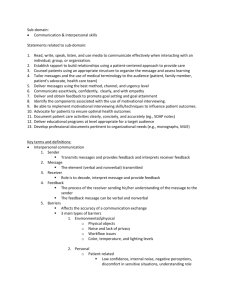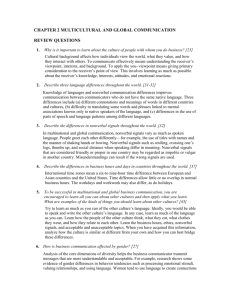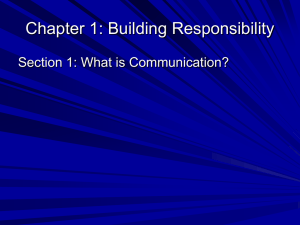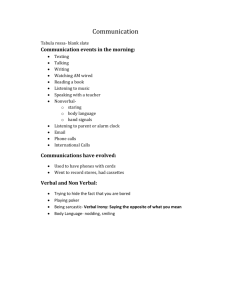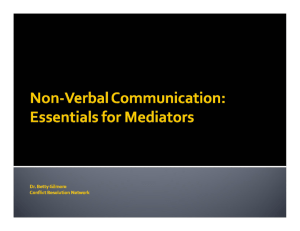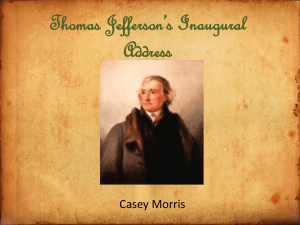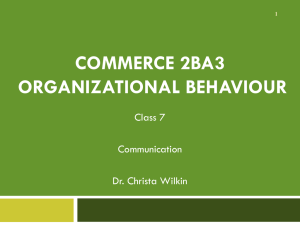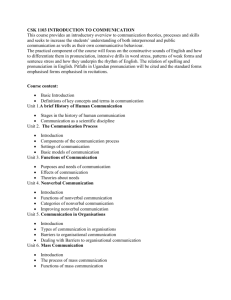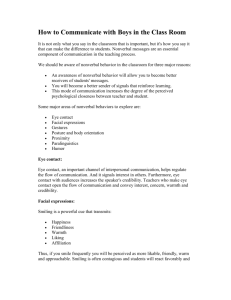NLP and Classroom Management
advertisement
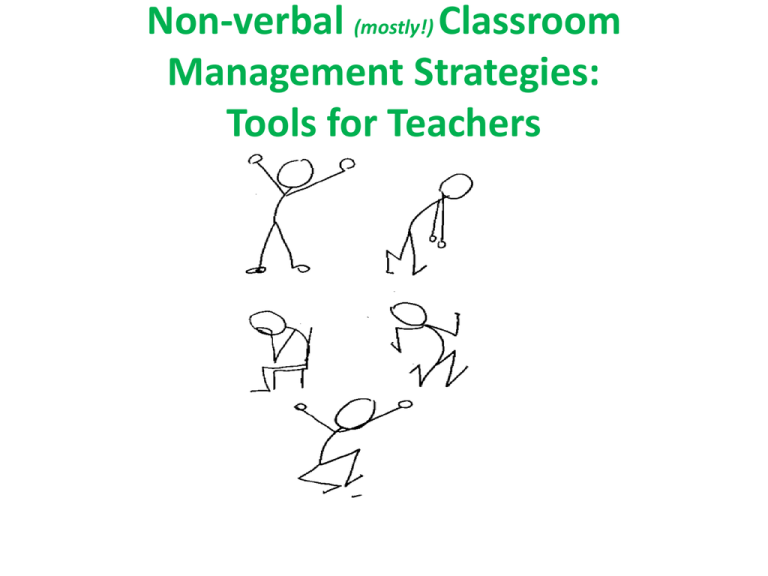
Non-verbal (mostly!) Classroom Management Strategies: Tools for Teachers Overview: Nonverbal Classroom Management Focus on methods within 5 major strategies: 1. 2. 3. 4. 5. Taking charge Using SPACE communication Setting procedures Expanding attention span Managing at-risk students Goals: • To learn and practice a few specific nonverbal techniques • Share in our group’s wealth of experience D Advantages of nonverbal communication in the classroom: • Saves teacher time, breath, distress • Gives the teacher more flexibility • Promotes “flow,” a calmer mood • Increases productivity • Helps students feel safe and secure (the base of Maslow’s hierarchy) • More trust between students and teacher • Students know what to expect • Increased teacherstudent rapport*** Good classroom management provides the foundation for learning! “You don’t learn until you’re happy, safe, and comfortable.” Robert Marzano Esteem Belonging in “Dimensions of Learning” Safety Physiological Nonverbal messages— what are some of yours? • Opening • Closing • B Test #1: What are the instructions? Silent Classroom Instructions: the 3-min. Challenge • Get in groups of three. • Choose a sender, a receiver, and an observer. • When I say “GO”, the sender will give a nonverbal instruction. • ASAP the receiver verbalizes the instruction. • Once agreed that the receiver is correct (sender nods head), the observer writes down the instruction. • Keep going as fast as you can, for as many instructions as possible in 3 minutes. • Demonstration • Ready, set, GO • Observers share! D Strategy #1: Taking Charge Taking charge: the most important 20 seconds • Each time you shift class activities, you take the stage again. • If the teachers STANDS STILL for 20 seconds after releasing the class to do seatwork, more students will go ON task independently. • Auditory students (1-5 in every class) need that time to replay the instructions in their heads need to learn to do this silently. The 20 seconds gives them time to do this. (An important skill to master for joining the workforce someday!) B Strategy # 2—Space Communication: Map Your Room • Designate several locations for one action only (an example follows) • Spatial memory is powerful—very Pavlovian! (car example) • Teach kids what each location means—and then use the system daily. • Repeat, repeat, repeat! D Post homework assignments in the SAME PLACE every day—ideally, in the upper left corner from the student’s viewpoint—the “remembering” spot B—mito-macarena, kinesthetic memory example Strategy #3 Setting Procedures for Conducting Class • Teacher only speaking • Raise your hand to speak •Speak out in turn *** Sharing: What are some nonverbal ways YOU have used to communicate which mode the class will be in? Strategy #4 Expanding Attention Span: Syllabic Breaks …this is when we can look at the ex---ponents and take a shortcut by… • A famously freaky syllabic break: ANTICI-------PATION!!!!!!!!!!!! D #4 cont’d— expanding student attention span “Silent lessons”—several formats possible: Overhead projector Charade With or without narrator Others? • B Strategy #4 cont’d—Expanding Attention Span, Re-establishing Control • Grounding – – – – – Examples: Museums Field trips Outdoors Cleanups • Standing on chair • Bells, lights, whistles ***Share: Favorite crowd control methods? Strategy #5: Interventions for At-Risk Students 1. YOUR ATTITUDE You are the at-risk student’s best and sometimes only hope. TODAY IS THE DAY!!! 2. Always give choices: Stand in hall or go to principal’s office? NON-CONFRONTATIONAL! 3. Pair them carefully LD and BD students can’t work with more than one partner. 4. Planned ignoring: Only respond when they behave appropriately See handout for dozens more practical strategies: “Interventions for At-Risk students” This concludes our presentation on non-verbal communication.
